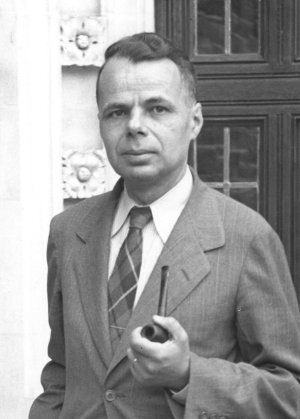
|
|
BIOGRAPHY OF L.W. NORDHEIM ( 1899 - 1985 ) |
Lothar Wolfgang Nordheim was born in Munich, Germany in 1899. In l923 he received his Ph. D. degree in Physics from the
University of Go"ttingen. In the following years he took part in the efforts to apply the quantum theory to the
understanding of atomic structure and to its behavior. As the tools of modern quantum theory became increasingly
available, he applied them to the study of solids, and made a long series of distinguished contributions to the early
development of solid state physics. Among his well known papers are those on the work function of metals, thermionic
emission from metals, the resistivity of metals and alloys, and the rectifying action of semiconductor - to-metal
contacts. Nordheimís interests were in the quantum theory of matter, the structure of metals, cosmic radiation and
nuclear physics. He worked with Edward Teller on the muon, a problem that arose from his interest in cosmic rays.
He was also very active in the early 30's on the Fermi theory of beta decay and he worked with Hans Bethe on meson decay.
His distinguished contributions to this field led him to be invited to write a long article for the famous Mueller
Pouillets Handbook of Physics, where he dealt with the statistical and kinetic theory of the metallic state, and the
quantum theory of magnetism. During this period he lectured at Gottingen, and was the holder of a Rockefeller Foundation
Research Fellowship, a Lorentz Fellowship, and he was also a Visiting Professor at the University of Moscow.
As a Jew, he had to leave Germany in 1934. After his tenure of a Lorentz research fellowship in Holland, he immigrated
to the U.S.A in 1934. He came to Purdue University as a Visiting Professor, under the sponsorship of the Emergency
Committee for Displaced German Scholars. At Purdue he directed the Ph. D. research of graduate students in the field of
solid state physics, while he began to turn his own attention to the study of cosmic rays. During the following years
he participated in the analyses of cosmic ray phenomena that finally led to the modern understanding of the role of
mesons in cosmic ray showers. In this work he collaborated with his wife, Gertrud Po"schl, who also worked actively on
the theory of the structure of polyatomic molecules and their spectra.
In 1937 Nordheim accepted a Professorship at Duke University. When the Manhattan project was set up, he was called upon
to accept important responsibilities at the Oak Ridge facility. He served as section chief in the "Clinton Laboratories",
the forerunner of the present Oak Ridge National Laboratory, and from 1945 to 1947 he was Director of the Physics
Division of that laboratory. In 1947 he returned to Duke, while continuing to serve as consultant at Oak Ridge and the
Los Alamos laboratory. During this period he 2worked on the theory of cosmic ray showers, and was one of the earliest
contributors to the development of the shell theory of nuclear structure. In 1956 he accepted a research position at the
John J. Hopkins Laboratory for Pure and Applied Science of General Atomics in San Diego, where he became Chairman of
the Theoretical Physics Department, and continued research in the fields in which he was involved in the early days at
Oak Ridge, namely reactor and neutron physics. He died in La Jolla on Oct. 5, 1985.
He received many honors, among them being an honorary Doctor of Science from the University of Karlsruhe in Germany in
1951 and from Purdue University in 1963. He was a Fellow of the American Physical Society. He gave the first
Fritz London Memorial Lecture at Duke University in 1956.
In 1935 Nordheim married Gertrud Poschl, who was also an physicist and who, after they came to Duke in 1937, worked in
Hertha Sponer's laboratory. Nordheim returned to Germany in the late 50's and while on this visit his wife was killed
in an automobile accident. L.C. Biedenharn, J.B. Duke Professor at Duke, reported (in 1989) that Nordheim had told him
that he had never really recovered from this blow and this was a major reason for leaving Duke University for California
to get a change.
From Biedenharnís point of view the most important work of Nordheim in the postwar period is his work on spins,
moments and shells in nuclei. He extended his interests in beta decay to include beta decay in the nuclear shell model.
Nordheim was one of the founders of the nuclear shell model and gave the basic coupling rules for spins in shells which
he had deduced from the analysis of weak interactions.
Although he does not know it for a fact, Biedenharn was convinced that Nordheim is the one who was instrumental in
getting Henry Newson to join Duke University after WW II and in setting the direction on the study of nuclear physics.
The nuclear laboratory, later known as TUNL (Triangle Universities Nuclear Laboratory), has been internationally known
and respected since the early 50's.
For more details on the works of L.W. Nordheim see Review article:
A.L.Kuzemsky, Works of D.I. Blokhintsev and Development of Quantum Physics
Physics of Particles and Nuclei, 2008, vol. 39, Issue 2, pp.137-172.
( http://theor.jinr.ru/~kuzemsky/preprints/Blokhintsev08.pdf)
(in English).
Russian version is available at:
Physics of Elementary Particles and Atomic Nuclei, 2008, vol. 39, Issue 1, pp.5-81.
http://theor.jinr.ru/~kuzemsky/preprints/DIBREV08.pdf.